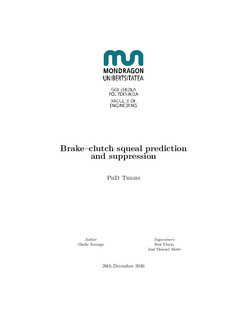| dc.rights.license | Attribution-NonCommercial-NoDerivatives 4.0 International | * |
| dc.contributor.advisor | Ulacia Garmendia, Ibai | |
| dc.contributor.advisor | Abete Huici, José Manuel | |
| dc.contributor.author | Zarraga, Ondiz | |
| dc.date.accessioned | 2020-06-11T12:21:21Z | |
| dc.date.available | 2020-06-11T12:21:21Z | |
| dc.date.issued | 2016 | |
| dc.date.submitted | 2016-12-19 | |
| dc.identifier.other | https://katalogoa.mondragon.edu/janium-bin/janium_login_opac.pl?find&ficha_no=128100 | en |
| dc.identifier.uri | https://hdl.handle.net/20.500.11984/1683 | |
| dc.description.abstract | This work studies the high frequency noise in brake–clutch systems known as squeal. The work is divided into two parts, the first is focused on the development of both a theoretical and experimental simplified model of a brake–clutch and the second is centred on squeal modelling in the real system.
For the simple model, on the theoretical side, a FE model was developed including anisotropic material properties, pressure and speed dependent friction coefficient and friction damping. The pertinent characterisation tests were performed as needed. On the experimental side, squeal tests were performed in the test bench in order to check the ability of the system for squeal prediction.
Once the model was thought as accurate enough, a methodology to decide over point structural modifications for squeal suppression based on the receptance function was designed. Using this process squeal was successfully eliminated from the simplified model both theoretically and experimentally.
In the second part the modelling of squeal in a real brake–clutch system was tackled. With this objective a FE model of the whole system was developed and its validity was checked first by EMA and after, comparing the experimental squeal frequencies with the ones predicted by simulation. To finish, the methodology for structural modifications previously designed was applied to the system and several theoretical modifications were proposed and studied. | en |
| dc.description.abstract | Lan honetan balazta–enbrage unitate konbinatuetan agertzen den squeal izeneko frekuentzia altuko zarata aztertzen da. Lana bi zatitan banatuta dago: alde batetik, balazta–enbragearen eredu sinplifikatu bat garatu da, bai teorikoa zein esperimentala; bestetik, squeala sistema errealean modelizatu da.
Eredu sinplean, alde teorikoari dagokionez, elementu finitutako eredu bat garatu da. Eredu honek marruskadura materialaren propietate anisotropoak, presio eta abiaduraren menpeko marruskadura koefizientea eta marruskadurak eragindako moteltzea kontutan hartzen ditu. Propietate hauek saiakuntza independentetan neurtu dira. Alde esperimentalean, squeal saiakuntzak burutu dira ereduak squeala aurreikusteko duen gaitasuna balioztatzeko asmoz.
Behin eredua nahiko zehatza izanik, zarata kentzeko aldaketa estrukturalak proposatu eta baloratzeko metodologia bat diseinatu da. Proposatutako metodoa errezeptantzia funtzioan oinarrituta dago. Metodo honi esker squeala eredu teorikoan lehenengo eta ondoren saiakuntza bankuan kentzea posible izan da.
Bigarren atalean, balazta–enbragearen modelizazioari ekin zaio squealari dagokionez. Helburu honekin, sistema osoaren eredu bat garatu da eta lehengo AME bidez eta gero squeal frekuentzia esperimentalak ereduak aurreikusitakoekin konparatuz balioztatu da. Azkenik, aldaketa estrukturalak proposatzeko metodologia sistema errealari aplikatu zaio eta aldaketa teoriko batzuk planteatu eta aztertu dira. | eu |
| dc.description.abstract | El presente trabajo estudia el ruido de alta frecuencia que se da en los freno-embragues conocido como squeal. El trabajo se divide en dos partes, la primera enfocada en el desarrollo de un modelo simple tanto teórico como experimental del freno–embrague y la segunda centrada en la modelización del squeal en el sistema real.
En lo referente al modelo simple, en la parte teórica se desarrolló un modelo de elementos finitos que incluía propiedades anisótropas para el material de fricción, un coeficiente de fricción dependiente de la presión y la velocidad y amortiguamiento por fricción. Estas propiedades se caraterizaron en los correspondientes ensayos independientes cuando fue necesario. En la parte experimental, se llevaron a cabo ensayos de squeal en banco con la idea de verificar la capacidad del modelo para predecir el squeal.
Una vez que el modelo se consideró lo suficientemente exacto, se desarrolló una metodología para proponer y valorar modificaciones estructurales para la supresión de squeal. El método propuesto está basado en la función de receptancia. Gracias a este proceso fue posible eliminar el squeal del modelo primero en la teoría y a continuación en el banco de ensayos.
En la segunda parte se aborda la modelización de squeal en un freno–embrague real. Con esto en mente se desarrolló un modelo de elementos finitos del sistema completo y se validó en primer lugar mediante AME y a continuación comparando las frecuencias experimentales de squeal con las predichas por la simulación. Por último, la metodología desarrollada para modificaciones estructurales se aplicó al sistema real y se propusieron y analizaron varias modificaciones teóricas. | es |
| dc.description.sponsorship | This work was supported by Goizper S. Coop. and IK4-Tekniker and funded by the Basque Government under the Manunet project BRAKESQ. | en |
| dc.format.extent | xxviii, 149 p. | en |
| dc.language.iso | eng | en |
| dc.publisher | Mondragon Unibertsitatea. Goi Eskola Politeknikoa | en |
| dc.rights | © Ondiz Zarraga Rio | en |
| dc.rights.uri | http://creativecommons.org/licenses/by-nc-nd/4.0/ | * |
| dc.subject | Ingeniería y tecnología mecánicas | es |
| dc.subject | Ruido | es |
| dc.subject | Fricción | es |
| dc.subject | Maquinaria industrial | es |
| dc.subject | ODS 10 Reducción de las desigualdades | es |
| dc.title | Brake-clutch squeal prediction and suppression | en |
| dcterms.accessRights | http://purl.org/coar/access_right/c_abf2 | en |
| local.description.degree | Programa de doctorado en ingeniería mecánica y energía eléctrica | es |
| local.description.responsability | Presidente: Dr. D. Rafael Avilés González (EHU-UPV); Vocal: Dr. D. Francesco Massi (University of Rome, La Sapienza)); Vocal: Dr. D. José Luis Olazagoitia Rodríguez (Universidad Antonio de Nebrija); Vocal: Dr. D. Javier Arrasate Ayerbe (Mondragon Unibertsitatea); Secretario: Dr. D. Jon Ander Esnaola Ramos (Mondragon Unibertsitatea) | es |
| local.identifier.doi | https://doi.org/10.48764/ee6s-b871 | |
| local.contributor.otherinstitution | https://ror.org/000xsnr85 | es |
| local.contributor.otherinstitution | https://ror.org/02be6w209 | en |
| local.contributor.otherinstitution | https://ror.org/03tzyrt94 | es |
| oaire.format.mimetype | application/pdf | |
| oaire.file | $DSPACE\assetstore | |
| oaire.resourceType | http://purl.org/coar/resource_type/c_db06 | en |








